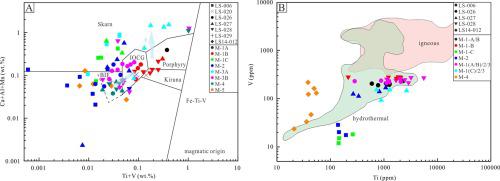当前位置:
X-MOL 学术
›
Ore Geol. Rev.
›
论文详情
Our official English website, www.x-mol.net, welcomes your feedback! (Note: you will need to create a separate account there.)
Textures and geochemistry of magnetite: indications for genesis of the Late Paleozoic Laoshankou Fe-Cu-Au deposit, NW China
Ore Geology Reviews ( IF 3.3 ) Pub Date : 2020-09-01 , DOI: 10.1016/j.oregeorev.2020.103632 Pei Liang , Chao Wu , Xia Hu , Yuling Xie
Ore Geology Reviews ( IF 3.3 ) Pub Date : 2020-09-01 , DOI: 10.1016/j.oregeorev.2020.103632 Pei Liang , Chao Wu , Xia Hu , Yuling Xie

|
Abstract Laser ablation-inductively coupled plasma-mass spectrometry (LA-ICP-MS) and electron probe X-ray microanalysis (EPMA) have been employed to determine major and trace elemental concentrations in magnetite from different ores in the Laoshankou deposit, which is the most important Fe-Cu-Au deposit in the northern margin of East Junggar. Two magnetite-associated paragenetic sequences have been defined in Laoshankou, including amphibole-epidote-magnetite alteration/mineralization (stage II) and pyrite-chalcopyrite mineralization (stage III-B). On the basis of the magnetite textures and chemical compositions, we have identified six generations of magnetite from three types of ores/rocks, including the high-Ti inclusion-rich M-1-A and inclusion-free M-1-B in massive magnetite-epidote-amphibole ores (type H1) from stage II; the low-Ti, high-Si, inclusion-rich M-1-C in massive magnetite-sulfide ores (type H2) from stage II; the ubiquitous low-Ti M-2 and pristine low-Ti, low-Si M-3 in both H1 and H2 types; and M-4 within massive chalcopyrite-magnetite ores (type H3) from stage III-B. The discriminations of V versus Ti, Ca + Mn + Al versus Ti + V, and Fe versus V/Ti, as well as mineral assemblages and trace element concentrations of Cr (
更新日期:2020-09-01



























 京公网安备 11010802027423号
京公网安备 11010802027423号